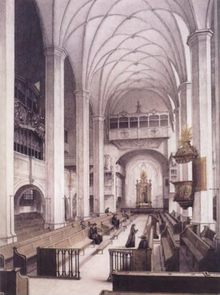Warum betrübst du dich, mein Herz, BWV 138
| Warum betrübst du dich, mein Herz | |
|---|---|
BWV 138 | |
| Church cantata by J. S. Bach | |
 Thomaskirche in Leipzig, where Bach's cantata Warum betrübst du dich, mein Herz was possibly first performed | |
| Occasion | 15th Sunday after Trinity |
| Bible text | Matthew 6:23–34 |
| Chorale | Warum betrübst du dich, mein Herz |
| Movements | seven |
| Vocal | SATB soloists and choir |
| Instrumental |
|
History and words
Bach wrote the cantata in his first year in Leipzig for the
Bach first performed the cantata on 5 September 1723. Bach used the only aria as a base for the Gratias of his
Scoring and structure
The cantata in seven movements is scored for soprano, alto, tenor and bass soloists, a four-part choir singing the chorale exclusively, and a Baroque instrumental ensemble of two oboes d'amore, two violins, viola, and basso continuo.[3]
- Chorale and recitative (alto): Warum betrübst du dich, mein Herz
- Recitative (bass): Ich bin veracht
- Chorale and recitative (soprano, alto): Er kann und will dich lassen nicht
- Recitative (tenor): Ach süßer Trost
- Aria (bass): Auf Gott steht meine Zuversicht
- Recitative (alto): Ei nun! So will ich auch recht sanfte ruhn
- Chorale: Weil du mein Gott und Vater bist
Note: the numbering of the movements follows Alfred Dürr. Other authorities do not consider the bass recitative as a separate movement.
Music
Bach followed the idea of the unusual text in a complex way in the two movements contrasting the chorale with recitative: in both, in lines 1 to 3 the strings open, the oboes enter, oboe I playing the chorale theme,[2] oboe II adding lamenting motifs, then the tenor enters singing the chorale line as an arioso, finally the choir sings the choral theme in a four-part setting; this is followed by the recitative of the questioning single voice, alto in the first movement, soprano in the later one, both accompanied by the strings. After the three lines and recitatives, lines 4 and 5 are sung by the choir in the first movement. In the later one lines 4 and 5 are first composed as an imitative choral movement on the chorale theme of line 4 in a five-part setting, the fifth part played by violin I. Then a final secco recitative leads to a repeat of lines 4 and 5, this time similar to the first movement.
The only aria in dancing
8 time is dominated by figuration of violin I. The third verse of the chorale ends the cantata in a simple choral setting embedded in orchestral music on an independent theme.[3]
The cantata's unusual structure has been criticized by his biographers
There is no question that BWV 138 is a highly original, experimental work, one that is simultaneously archaic, especially in the motet-like writing … and modern in Bach's way of grappling with three successive stanzas of a sixteenth-century chorale, in anticipation of the chorale-based cantatas of his second Leipzig cycle. It is a clever device which allows him to pile on the tension between anxiety (the solo recitative interjections) and belief (the choral delivery of the hymn stanzas). The cantata's turning-point occurs midway – a dawning realisation that God will come to the believer’s rescue... with an outspoken declaration of trust in His providential care. The elaborate fantasia in 6
8 for the final chorale is a perfect – and well-planned – counterbalance to the gloom and distress of the opening movements.[4]
Recordings
- Bach Made in Germany Vol. 1 – Cantatas VII, Gewandhausorchester, soloists of the Thomanerchor, Gert Lutze, Johannes Oettel, Eterna 1953
- J. S. Bach: Cantatas BWV 136 & BWV 138, Marie-Luise Gilles, Alexander Young, Carl-Heinz Müller, Cantate 1960
- Die Bachkantate Vol. 50, Hänssler1978
- J. S. Bach: Mit Fried und Freud, Philippe Herreweghe, Collegium Vocale Gent, Deborah York, Ingeborg Danz, Mark Padmore, Peter Kooy, Harmonia Mundi France 1998
- J. S. Bach: Cantatas Vol. 11, Masaaki Suzuki, Bach Collegium Japan, Midori Suzuki, Kai Wessel, Makoto Sakurada, Peter Kooy, BIS 1998
- J. S. Bach: Complete Cantatas Vol. 9, Ton Koopman, Amsterdam Baroque Orchestra & Choir, Caroline Stam, Bernhard Landauer, Christoph Prégardien, Klaus Mertens, Antoine Marchand 1998
- Bach Cantatas Vol. 8, Soli Deo Gloria2000
References
- ^ Dellal, Pamela. "BWV 138 – Warum betrübst du dich, mein Herz?". Emmanuel Music. Retrieved 1 September 2022.
- ^ a b "Chorale Melodies used in Bach's Vocal Works / Warum betrübst du dich, mein Herz". Bach Cantatas Website. 2006. Retrieved 6 September 2010.
- ^ ISBN 3-423-04080-7.
- ^ a b Gardiner, John Eliot (2006). Johann Sebastian Bach (1685-1750) / Cantatas Nos 8, 27, 51, 95, 99, 100, 138 & 161 (Media notes). Soli Deo Gloria (at Hyperion Records website). Retrieved 7 September 2018.
Sources
- Warum betrübst du dich, mein Herz, BWV 138: Scores at the International Music Score Library Project
- Warum betrübst du dich, mein Herz BWV 138; BC A 132 / Sacred cantata (15th Sunday after Trinity) Bach Digital
- Cantata BWV 138 Warum betrübst du dich, mein Herz? history, scoring, sources for text and music, translations to various languages, discography, discussion, Bach Cantatas Website
- BWV 138 Warum betrübst du dich, mein Herz? English translation, University of Vermont
- BWV 138 Warum betrübst du dich, mein Herz? text, scoring, University of Alberta
- Chapter Chapter 18 BWV 138 Warum betrübst du dich mein Herz / My heart, what ails you? Julian Mincham, 2010
